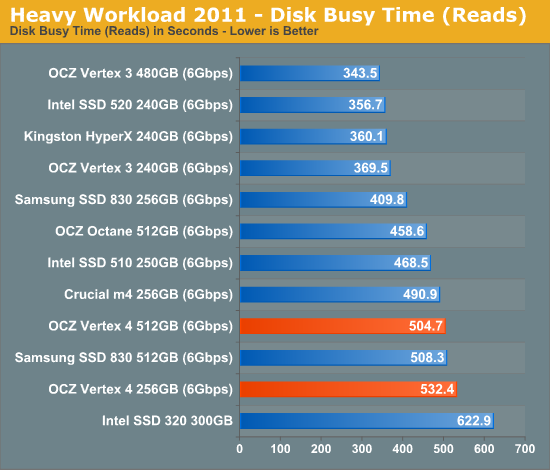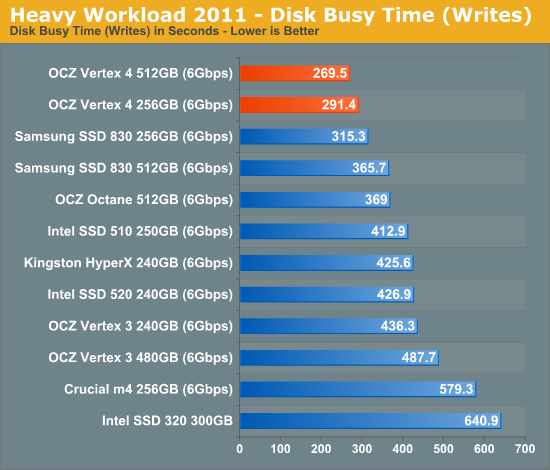OCZ Vertex 4 Review (256GB, 512GB)
by Anand Lal Shimpi on April 4, 2012 9:00 AM ESTAnandTech Storage Bench 2011
Two years ago we introduced our AnandTech Storage Bench, a suite of benchmarks that took traces of real OS/application usage and played them back in a repeatable manner. I assembled the traces myself out of frustration with the majority of what we have today in terms of SSD benchmarks.
Although the AnandTech Storage Bench tests did a good job of characterizing SSD performance, they weren't stressful enough. All of the tests performed less than 10GB of reads/writes and typically involved only 4GB of writes specifically. That's not even enough exceed the spare area on most SSDs. Most canned SSD benchmarks don't even come close to writing a single gigabyte of data, but that doesn't mean that simply writing 4GB is acceptable.
Originally I kept the benchmarks short enough that they wouldn't be a burden to run (~30 minutes) but long enough that they were representative of what a power user might do with their system.
Not too long ago I tweeted that I had created what I referred to as the Mother of All SSD Benchmarks (MOASB). Rather than only writing 4GB of data to the drive, this benchmark writes 106.32GB. It's the load you'd put on a drive after nearly two weeks of constant usage. And it takes a *long* time to run.
1) The MOASB, officially called AnandTech Storage Bench 2011 - Heavy Workload, mainly focuses on the times when your I/O activity is the highest. There is a lot of downloading and application installing that happens during the course of this test. My thinking was that it's during application installs, file copies, downloading and multitasking with all of this that you can really notice performance differences between drives.
2) I tried to cover as many bases as possible with the software I incorporated into this test. There's a lot of photo editing in Photoshop, HTML editing in Dreamweaver, web browsing, game playing/level loading (Starcraft II & WoW are both a part of the test) as well as general use stuff (application installing, virus scanning). I included a large amount of email downloading, document creation and editing as well. To top it all off I even use Visual Studio 2008 to build Chromium during the test.
The test has 2,168,893 read operations and 1,783,447 write operations. The IO breakdown is as follows:
| AnandTech Storage Bench 2011 - Heavy Workload IO Breakdown | ||||
| IO Size | % of Total | |||
| 4KB | 28% | |||
| 16KB | 10% | |||
| 32KB | 10% | |||
| 64KB | 4% | |||
Only 42% of all operations are sequential, the rest range from pseudo to fully random (with most falling in the pseudo-random category). Average queue depth is 4.625 IOs, with 59% of operations taking place in an IO queue of 1.
Many of you have asked for a better way to really characterize performance. Simply looking at IOPS doesn't really say much. As a result I'm going to be presenting Storage Bench 2011 data in a slightly different way. We'll have performance represented as Average MB/s, with higher numbers being better. At the same time I'll be reporting how long the SSD was busy while running this test. These disk busy graphs will show you exactly how much time was shaved off by using a faster drive vs. a slower one during the course of this test. Finally, I will also break out performance into reads, writes and combined. The reason I do this is to help balance out the fact that this test is unusually write intensive, which can often hide the benefits of a drive with good read performance.
There's also a new light workload for 2011. This is a far more reasonable, typical every day use case benchmark. Lots of web browsing, photo editing (but with a greater focus on photo consumption), video playback as well as some application installs and gaming. This test isn't nearly as write intensive as the MOASB but it's still multiple times more write intensive than what we were running in 2010.
As always I don't believe that these two benchmarks alone are enough to characterize the performance of a drive, but hopefully along with the rest of our tests they will help provide a better idea.
The testbed for Storage Bench 2011 has changed as well. We're now using a Sandy Bridge platform with full 6Gbps support for these tests.
AnandTech Storage Bench 2011 - Heavy Workload
We'll start out by looking at average data rate throughout our heavy workload test:
The overall score here is in-line with the SF-2281 solutions and OCZ's Octane. Our heavy workload is fairly write intensive, so I honestly expected the Vertex 4 to top the charts. Looking at the read/write breakdown explains why though:

Here we see the Vertex 4's poor low queue-depth sequential read performance rearing its head once more. Look at the sequential write speed and you'll see where OCZ makes up for its shortcomings however. The Vertex 4 writes quicker than any drive we've tested.

It's a tough tradeoff to come to terms with. The Vertex 4 delivers performance when it matters the most, but typically you want the absolute best performance regardless of workload. All of this may become moot if OCZ is able to address the situation with a firmware update in the coming weeks like it promised, but for buyers today it is something you have to think about.
The next three charts just represent the same data, but in a different manner. Instead of looking at average data rate, we're looking at how long the disk was busy for during this entire test. Note that disk busy time excludes any and all idles, this is just how long the SSD was busy doing something:














127 Comments
View All Comments
Kristian Vättö - Wednesday, April 4, 2012 - link
Samsung 830 is "a lot" faster, see our Heavy and Light benches. In real world, you will probably not notice the difference unless you do something I/O intensive. Personally, I've been recommending both Crucial m4 and Samsung 830. Crucial is great if you want to save a few bucks but otherwise Samsung is better. I think Anand has been using the Samsung in his main system for months now and haven't had issues, so that may be a reason as well. After all, we speak based on our own experience.kristof007 - Thursday, April 5, 2012 - link
I've been looking around for articles and just looked at bench marks (ignore the M3 and Vertex 4 reviews) and it seemed like the Crucial m4 was hands down the best drive. I purchased it yesterday via Newegg for $299 (it was on sale). Sounds like I won't be disappointed.I was wondering if you guys could maybe have like a top 3 list for SSDs (or heck .. for all categories) with quick pro's and con's for what is out at the moment and what is the best one performance wise.
By the way, I haven't been reading much AT lately, but I've seen a few of your articles and would like to thank you for your work!
nathanddrews - Wednesday, April 4, 2012 - link
The 830 offers up nearly the best "real world" disk busy performance in both the light and heavy benchmarks and has proven to be extremely reliable and consistent without being very expensive. The M4 is great... but a bit outdated performance-wise (not as fast as the 830).antef - Wednesday, April 4, 2012 - link
Thanks for the replies. I guess I saw them as trading places a good bit in the benchmarks, but I do see that the 830 often comes out on top. I guess I figured the performance difference is practically nil for mainstream uses and the M4 seems more highly reviewed. But the 830 has been out for less time, so that may improve over time.nathanddrews - Wednesday, April 4, 2012 - link
That's just it - the differences in overall performance aren't likely to keep one awake at night. In the case of a person that has never used an SSD, just about any SSD available online today will completely shock and awe.An SSD that is 20% faster than another SSD which are both 900% faster than a 5400RPM HDD... not a big deal.
antef - Wednesday, April 4, 2012 - link
"Shock and awe" is the correct way to describe my feelings the first time I saw Windows boot in 3 seconds. :)beginner99 - Wednesday, April 4, 2012 - link
Price wise for average user the m4 is the best bang for the buck. Here its the cheapest sata-3 128 GB drive and 20$ cheaper than the Samsung. Also m4 uses less power, eg better for a laptop.ExarKun333 - Wednesday, April 4, 2012 - link
Looks like a trade-off that gave-up read performance for write performance with poor power consumption. Based on the charts, the HyperX 240GB or the Intel 520 would be better all-around options. The OCZ name also doesn't inspire a lot of confidence when it comes to reliability or support. They will really need up their game for customer service this generation to build some confidence in them.alan1476 - Wednesday, April 4, 2012 - link
If you are not impressed by this drive the review did not do this drive justice. If someone reviews a drive especially an SSD you have to understand the inner workings and just how it applys itself to applications in the real world. This SSD is ground breaking.cknobman - Wednesday, April 4, 2012 - link
I see no Sandforce 512gb drives shown in the performance charts.Its pretty common knowledge that SSD performance goes up with capacity and showcasing the Vertex 4 512gb drive against either smaller SSD's or older controllers makes it look better than it likely is.
Did anyone notice the abysmal speeds for the 120gb model???
I also noticed pretty high power consumption.
I don't consider this review proper until you place a 2nd Gen 512gb SandForce drive in the charts to compare directly against the 512gb Vertex 4 drive.